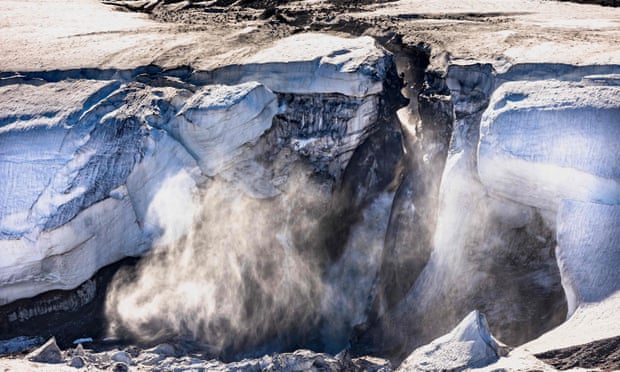
Major sea-level rise from the melting of the Greenland ice cap is now inevitable, scientists have found, even if the fossil fuel burning that is driving the climate crisis were to end overnight.
The research shows the global heating to date will cause an absolute minimum sea-level rise of 27cm (10.6in) from Greenland alone as 110tn tonnes of ice melt. With continued carbon emissions, the melting of other ice caps and thermal expansion of the ocean, a multi-metre sea-level rise appears likely.
Billions of people live in coastal regions, making flooding due to rising sea levels one of the greatest long-term impacts of the climate crisis. If Greenland’s record melt year of 2012 becomes a routine occurrence later this century, as is possible, then the ice cap will deliver a “staggering” 78cm of sea-level rise, the scientists said.
Previous studies have used computer models of ice cap behaviour to estimate future losses, but the physical processes are complex and this leads to significant uncertainties in the results.
In contrast, the study published in the journal Nature Climate Change used satellite measurements of ice losses from Greenland and the shape of the ice cap from 2000-19. This data enabled the scientists to calculate how far global heating to date has pushed the ice sheet from an equilibrium where snowfall matches the ice lost. This allowed the calculation of how much more ice must be lost in order to regain stability.
“It is a very conservative rock-bottom minimum,” said Prof Jason Box from the National Geological Survey of Denmark and Greenland (Geus), who led the research. “Realistically, we will see this figure more than double within this century.”
The 27cm estimate is a minimum because it only accounts for global heating so far and because some ways in which glacier ice is lost at the margins of the ice sheet are not included.
The advantage of this study is that it provides a solid estimate of inevitable sea-level rise but the method used does not give a timescale over which the ice will be lost. Nonetheless, based on scientists’ overall understanding of how sheets such as Greenland lose ice into the ocean, the researchers said most of the rise would occur relatively soon. In 2021, other scientists warned that a significant part of the Greenland ice sheet was on the brink of a tipping point.
“The minimum of 27cm is the sea-level rise deficit that we have accrued to date and it’s going to get paid out, no matter what we do going forward,” said Dr William Colgan, also at Geus. “Whether it’s coming in 100 years or 150 years, it’s coming. And the sea-level rise we are committed to is growing at present, because of the climate trajectory we’re on.”
Colgan said: “If [2012] becomes a normal year, then the committed loss grows to 78cm, which is staggering, and the fact that we’re already flickering into that range [of ice loss] is shocking. But the difference between 78cm and 27cm highlights the [difference] that can be made through implementing the Paris agreement. There is still a lot of room to minimise the damage.”
Mountain glaciers in the Himalayas and the Alps are already on course to lose a third and half of their ice respectively, while the west Antarctic ice sheet is also thought by some scientists to be past the point at which major losses are inevitable. Warming oceans also expand, adding to sea-level rise.
“There is growing support in the scientific literature for multi-metre levels of rise within the next 100 to 200 years,” said Colgan. A collapse of the colossal east Antarctic ice sheet, which would lead to a 52-metre rise in sea levels if it all melted, could be averted if rapid climate action is taken.
Prof Gail Whiteman, at the University of Exeter, who was not part of the study team, said: “The results of this new study are hard to ignore for all business leaders and politicians concerned about the future of humanity. It is bad news for the nearly 600 million people that live in coastal zones worldwide. As sea levels rise, they will be increasingly vulnerable, and it threatens approximately $1tn of global wealth.” She said political leaders must rapidly scale up funding for climate adaptation and damage.

Leave A Comment